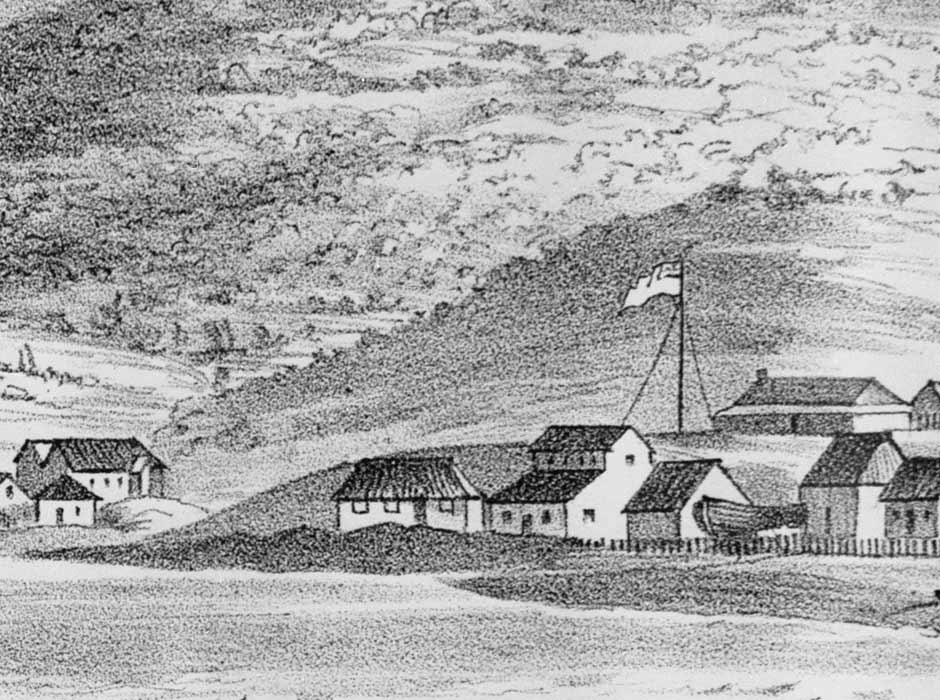
Detail from lithograph of Wellington in 1841 by Luke Nattrass. The library is to the left of Barrett's Hotel – the double-storeyed building in the centre of the image. (See the full image on the National Library's website).
New Zealand’s first public library
New Zealand's first public library, the Port Nicholson Exchange and Public Library, opened in Wellington in 1841. Established by a group of the city's first settlers, it operated for one year in a building on the corner of Charlotte Street (now Molesworth Street) and Lambton Quay, an area now occupied by the Wellington cenotaph. In 1842, due to a combination of defaulting subscribers and competitors, it closed and offered its contents to the Mechanics' Institute that was about to be established. The Institute and other groups continued to provide library services to the city until 1893, when Wellington City Council established a council-owned public library on the corner of Mercer and Wakefield Streets, not far from what is now the central branch of Wellington City Libraries.
The foundations for the Port Nicholson Exchange and Public Library were laid long before settlers even began arriving in the New Zealand Company settlement in 1840. Prior to the departure of the first ships, a committee had been established to ‘make provision for the Literary, Scientific and Philanthropic Institutions of the new Colony'. This ensured that the first settlers arrived laden with donations of books.
The burgeoning level of donations prompted a group of the city's first settlers to meet at Barrett's Hotel on 1 December 1840, and to resolve to establish ‘a library and reading room’. The New Zealand Company's principal agent, Colonel William Wakefield, and the chief police magistrate, Michael Murphy, were among those attending. In the days that followed the newly formed Committee appointed Dr Frederick Knox as librarian, at a salary of £75. They also purchased Richard Barrett's house, on the corner of Charlotte Street (now Molesworth Street) and Lambton Quay, as their premises for £30.
The library began operating from this location on 4 May 1841, but it was not a success. It was poorly located – the bulk of the population was then living in Te Aro. Its membership fee of £5, with a further £2 annual subscription, and its fees for other subscribers of £1 10s for the exchange, or £2 10s for both the library and exchange, also put it financially beyond the reach of most settlers (the equivalent of more than $700 for membership or $100-$200 for a subscription in 2009). Almost immediately after the Committee announced the library's formation, a public meeting of the ‘working classes of Port Nicholson' was called to discuss the formation of its own library, declaring that their incomes were not sufficient to pay the proposed library's fees. They expressed outrage that they would be prevented from accessing the books ‘sent from England by the well-wishers of this Colony for the benefit of all'.
Although the Working Men's Association failed to establish a library, a competing exchange (providing access to newspapers and periodicals) soon arose. The Wellington Exchange was more affordable, at a cost of £2 2s per annum, and was also situated in the more heavily populated Te Aro. Both establishments advertised their services steadily from May to July 1841. But while the fortunes of the Wellington Exchange rose - it opened new premises in November - the Port Nicholson Exchange and Public Library struggled even to get its original members to pay their subscriptions. In April 1842 the subscribers of the library resolved to wind up its affairs and to present the building and its collection to the Mechanics' Institute that was in the process of being established.
Despite the Committee's best efforts to find a successor, access to the library was not assured for almost another decade. The Mechanics' Institute closed the library in October 1843, leaving the collection to moulder in the offices of the New Zealand Company for seven years. It finally reopened in 1850 under the name of the Wellington Athenaeum and Mechanics' Institute. In 1892 the Athenaeum offered Wellington City Council the opportunity to purchase the collection it had inherited from the Port Nicholson Exchange and Public Library and the Mechanics' Institute for its new public library. This opened on the corner of Mercer and Wakefield Streets in 1893, with the collection forming the basis of its lending service. Wellington Public Library issued its first free library book in 1951.
Further information
- Stuart Perry, ‘Public libraries and the city's culture', Wellington prospect: survey of a city 1840-1970, ed. by Norman McLeod, Hicks Smith, Wellington, 1970.
- Mary Ronnie, A history of Wellington public libraries: administration report, New Zealand Library School, Wellington, 1952.
- Joan Stevens, ‘Brother Fred and the two cultures: New Zealand's first librarian', New Zealand Libraries, Vol 31 No 5, October 1968.
- Louis E. Ward, Early Wellington, Auckland, Whitcombe & Tombs, 1929, p. 268.


Community contributions